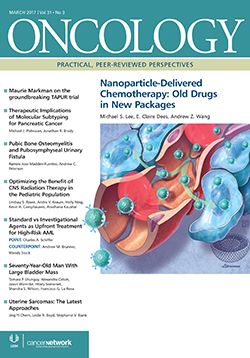COUNTERPOINT: Standard vs Investigational Agents as Upfront Treatment for High-Risk AML
As we learn more about the biology of AML, it appears that 7+3 only rarely clears residual leukemic clones in patients with higher-risk disease. New therapies are needed that can target and eradicate resistant subclones early in the disease course.
Oncology (Williston Park). 31(3):190, 192.

Andrew M. Brunner, MD

Wendy Stock, MD

Depth of Remission Is Key-and This Requires New Strategies
Acute myeloid leukemia (AML) is an aggressive malignancy of myeloid progenitors that is more common among older adults, with a median age at diagnosis of nearly 70 years. Many AML patients have higher-risk disease, either due to the presence of adverse cytogenetic and molecular abnormalities that confer resistance to standard chemotherapy,[1] or due to concurrent comorbid conditions that limit a patient’s ability to receive standard treatment.
For decades, “7+3” chemotherapy (cytarabine plus an anthracycline) has remained the standard initial treatment for AML (excluding acute promyelocytic leukemia); indeed, this combination yields reasonable response rates, with approximately 70% of younger patients achieving an initial morphologic remission. The rates of remission in higher-risk disease are much lower, however, with only about 40% of patients achieving a first remission.[2] Modifications to the regimen, such as the use of higher doses of daunorubicin during induction, may improve the morphologic complete remission (CR) rate among high-risk AML patients to roughly 60%,[3] but have failed to improve the overall survival of high-risk patients-both those younger than age 60 with unfavorable cytogenetics[4] and those over age 60 without core binding factor abnormalities[3]; the survival rate at 5 years in both groups is only about 20%. With current standard therapies, a CR in high-risk disease may at best provide a tantalizing glimpse of response, only to be followed by relapse and limited salvage options for the majority of patients.
That such uninspiring regimens represent the standard initial treatment for AML patients is not for lack of trying. Initial therapy in AML seeks to achieve a CR, and no agents have convincingly supplanted 7+3, based on our current understanding of treatment efficacy. That said, even with risk-adapted consolidation strategies and expanded indications for allogeneic transplantation, relapse in high-risk AML is frequent and remains the primary cause of death.
A major development in AML is the discovery that early deep clearance of leukemic clones (ie, the achievement of negative minimal residual disease [MRD] status) provides valuable prognostic information and may largely inform the subsequent clinical course. Even in relatively chemosensitive disease, such as NPM1-mutated AML, detection of residual disease using reverse-transcriptase quantitative polymerase chain reaction was associated with a dismal 24% overall survival rate.[5,6] For patients with high-risk disease, standard therapy rarely clears MRD,[7] and the majority of these patients will relapse, even with allogeneic transplant.[8] Given what we are learning about the kinetics of subclonal response, it is critical that new initial treatment strategies be developed that can effectively and rapidly achieve MRD-negative status.
Perhaps even more challenging are those patients with high-risk AML who are not eligible for standard induction regimens, and who are relegated to lower-intensity regimens, such as DNA methyltransferase inhibitors or low-dose cytarabine. These regimens offer some advantages for certain patients, such as outpatient administration, but the responses to them are dismal, with fewer than 20% of patients achieving a CR.[9] Interestingly, some patients who have historically poor responses to 7+3 may have a more favorable response to treatment with epigenetic therapies; for instance, there are emerging data showing that decitabine may be effective in clearing a TP53-mutated AML clone.[10] Nonetheless, even among responding patients, the current use of these agents is primarily palliative. In an era of new molecular targets and more tolerable therapies, it is difficult to consider the current lower-intensity options an adequate standard.
The standard of care for upfront AML therapy has remained 7+3 for decades. There is a degree of comfort with the combination, and with knowing that it can consistently provide the impression of good early responses; however, as we learn more about the biology of AML, it appears that this combination only rarely clears residual leukemic clones in patients with higher-risk disease. New therapies are needed that can target and eradicate resistant subclones early in the disease course; an example is the multikinase inhibitor midostaurin, which when added to 7+3 induction has been found to be of benefit in patients with FLT3-mutated AML, a subgroup associated with high rates of relapse and poor outcomes with standard therapy.[11] With more novel targets being identified, along with the evolving approach to MRD, the real standard of care for high-risk AML should be to consider novel therapeutic strategies whenever possible.
Financial Disclosure:The authors have no significant financial interest in or other relationship with the manufacturer of any product or provider of any service mentioned in this article.
References:
1. Lindsley RC, Mar BG, Mazzola E, et al. Acute myeloid leukemia ontogeny is defined by distinct somatic mutations. Blood. 2015;125:1367-76.
2. Appelbaum FR, Gundacker H, Head DR, et al. Age and acute myeloid leukemia. Blood. 2006;107:3481-5.
3. Löwenberg B, Ossenkoppele GJ, van Putten W, et al. High-dose daunorubicin in older patients with acute myeloid leukemia. N Engl J Med. 2009;361:1235-48.
4. Fernandez HF, Sun Z, Yao X, et al. Anthracycline dose intensification in acute myeloid leukemia. N Engl J Med. 2009;361:1249-59.
5. Ivey A, Hills RK, Simpson MA, et al. Assessment of minimal residual disease in standard-risk AML. N Engl J Med. 2016;374:422-33.
6. Chen X, Xie H, Wood BL, et al. Relation of clinical response and minimal residual disease and their prognostic impact on outcome in acute myeloid leukemia. J Clin Oncol. 2015;33:1258-64.
7. Klco JM, Miller CA, Griffith M, et al. Association between mutation clearance after induction therapy and outcomes in acute myeloid leukemia. JAMA. 2015;314:811-22.
8. Araki D, Wood BL, Othus M, et al. Allogeneic hematopoietic cell transplantation for acute myeloid leukemia: time to move toward a minimal residual disease–based definition of complete remission? J Clin Oncol. 2015;34:329-36.
9. Dombret H, Seymour JF, Butrym A, et al. International phase 3 study of azacitidine vs conventional care regimens in older patients with newly diagnosed AML with >30% blasts. Blood. 2015;126:291-9.
10. Uy GL, Duncavage EJ, Chang GS, et al. Dynamic changes in the clonal structure of MDS and AML in response to epigenetic therapy. Leukemia. 2016 Nov 18. [Epub ahead of print]
11. Stone RM, Mandrekar S, Sanford BL, et al. The multi-kinase inhibitor midostaurin (M) prolongs survival compared with placebo (P) in combination with daunorubicin (D)/cytarabine (C) induction (ind), high-dose C consolidation (consol), and as maintenance (maint) therapy in newly diagnosed acute myeloid leukemia (AML) patients (pts) age 18-60 with FLT3 mutations (muts): an international prospective randomized (rand) P-controlled double-blind trial (CALGB 10603/RATIFY [Alliance]). Blood. 2015;126:abstr 6.
